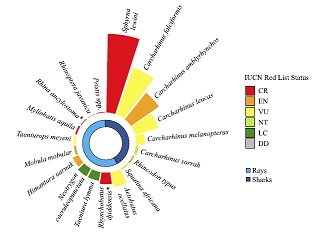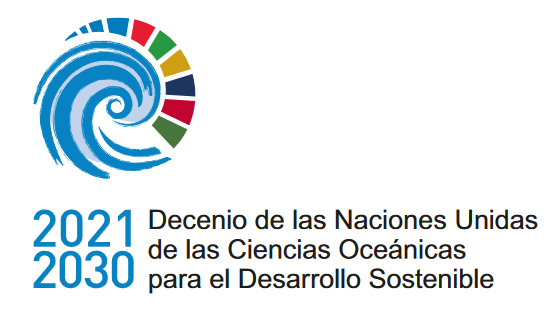Estado y características de los tiburones y rayas impactados por la pesca artesanal: potenciales implicancias para el manejo y la conservación
DOI:
https://doi.org/10.47193/mafis.3812025010101Palabras clave:
Manejo de pesquerías artesanales, especies amenazadas, captura de juveniles, conservaciónResumen
La pesca artesanal en Kenia enfrenta desafíos sustanciales, incluida una aplicación inadecuada, la ausencia de regulaciones adaptadas para la conservación de los elasmobranquios y la falta de sistemas sólidos de recopilación de datos, lo que dificulta la comprensión de las pesquerías y los aspectos biológicos de las especies. Para abordar estos desafíos, nuestro estudio examinó la composición de especies, el tamaño, el peso y el número de desembarques de tiburones y rayas en tres sitios históricamente conocidos por sus altas capturas de elasmobranquios. La investigación tuvo como objetivo caracterizar la pesquería de elasmobranquios de Kenia y exhibir su superposición con los hábitats clave. Los hallazgos son preocupantes, ya que 79% de las especies pesqueras desembarcadas están clasificadas como amenazadas en la Lista Roja de la UICN. Esto incluye al tiburón martillo festoneado (Sphyrna lewini) en peligro crítico de extinción, y al pez guitarra de manchas blancas (Rhynchobatus djiddensis), ambas especies capturadas con frecuencia. Además, 97% de los tiburones y 46% de las rayas son desembarcados como individuos neonatos e inmaduros. Son imperativos los cambios urgentes en la gestión pesquera nacional para prevenir la posible desaparición local de varias especies de tiburones y rayas. Recomendamos medidas de conservación específicas para reducir la captura de los juveniles de las especies amenazadas, tales como prohibir el desembarco de especies amenazadas y establecer límites de tamaño mínimo. Hacer cumplir las regulaciones pesqueras, como el tamaño de la malla, y priorizar la protección de los hábitats de las especies en mayor riesgo son pasos proactivos esenciales.
Descargas
Métricas
Citas
Anam R, Mostarda E. 2012. Field identification guide to the living marine resources of Kenya. FAO Species Identification Guide for Fishery Purposes. Rome: FAO. p. 357.
Bennett RH, van Beuningen D, Bräutigam A, Bürgener MCR, Bladon A, Kiszka JJ, Leeney RH, Okes N, Samoilys M. 2022. Chondrichthyans of the Western Indian Ocean: biodiversity, fisheries and trade, management and conservation. A status report prepared by the Wildlife Conservation Society for the Nairobi Convention for the Protection, Management and Development of the Marine and Coastal Environment of the Eastern African Region. New York: Wildlife Conservation Society. 339 p.
Booth H, Mourato S, Milner-Gulland EJ. 2022. Investigating acceptance of marine tourism levies, to cover the opportunity costs of conservation for coastal communities. Ecol Econ. 201: 107578.
Byers O, Copsey J, Lees C, Miller P, Traylor-Holzer K. 2022. Reversing the decline in threatened species through effective conservation planning. Diversity. 14 (9): 754.
Compagno LJ. 1984. FAO species catalogue. Vol. 4. Sharks of the world. An annotated and illustrated catalogue of shark species known to date. Part 2. Carcharhiniformes. FAO Fish Synop. 125.
Cortés E. 2004. Life history patterns, demography and population dynamics. In: Carrier JC, Musick JA, Heithaus MR, editors. Biology of sharks and their relatives. Boca Raton: CRC Press. p. 449-470.
Cuevas‐Gómez GA, Pérez‐Jiménez JC, Méndez‐Loeza I, Carrera‐Fernández M, Castillo‐Géniz JL. 2020. Identification of a nursery area for the critically endangered hammerhead shark (Sphyrna lewini) amid intense fisheries in the southern Gulf of Mexico. J Fish Biol. 97 (4): 1087-1096.
Davidson LN, Krawchuk MA, Dulvy NK. 2016. Why have global shark and ray landings declined: improved management or overfishing? Fish and Fish. 17 (2): 438-458.
Dell’Apa A, Chad Smith M, Kaneshiro-Pineiro MY. 2014. The influence of culture on the international management of shark finning. Environ Manage. 54: 151-161.
Dulvy NK, Pacoureau N, Rigby CL, Pollom RA, Jabado RW, Ebert DA, Finucci B, Pollock CM, Cheok J, Derrick DH, Herman KB. 2021. Overfishing drives over one-third of all sharks and rays toward a global extinction crisis. Curr Biol. 31 (21): 4773-4787.
Dulvy NK, Pardo SA, Simpfendorfer CA, Carlson JK. 2014. Diagnosing the dangerous demography of manta rays using life history theory. PeerJ. 2: e400.
Dulvy NK, Simpfendorfer CA, Davidson LN, Fordham SV, Bräutigam A, Sant G, Welch DJ. 2017. Challenges and priorities in shark and ray conservation. Curr Biol. 27 (11): 565-572.
Duncan KM, Holland KN. 2006. Habitat use, growth rates and dispersal patterns of juvenile scalloped hammerhead sharks Sphyrna lewini in a nursery habitat. Mar Ecol Prog Ser. 312: 211-221.
Ebert DA, Dando M, Fowler S. 2021. Sharks of the world: a complete guide. Vol. 22. Princeton University Press.
Filmalter J, Cowley P, Forget F, Dagorn L. 2015. Fine-scale 3-dimensional movement behaviour of silky sharks Carcharhinus falciformis associated with fish aggregating devices (FADs). Mar Ecol Prog Ser. 539: 207-223.
Froese R, Binohlan C. 2000. Empirical relationships to estimate asymptotic length, length at first maturity and length at maximum yield per recruit in fishes, with a simple method to evaluate length frequency data. J Fish Biol. 56 (4): 758-773.
Froese R, Pauly D, editors. 2023. FishBase. World Wide Web electronic. [accessed 2023 Jun 6]. https://www.fishbase.org.
Fulanda B, Ohtomi J, Mueni E, Kimani E. 2011. Fishery trends, resource-use and management system in the Ungwana Bay fishery Kenya. Ocean Coast Manage. 54 (5): 401-414.
Gallagher AJ, Serafy JE, Cooke SJ, Hammerschlag N. 2014. Physiological stress response, reflex impairment, and survival of five sympatric shark species following experimental capture and release. Mar Ecol Prog Ser. 496: 207-218.
Government of Kenya. 2013. The Wildlife Conservation and Management Act 2013. Nairobi: Government Printer. [accessed 2023 Jun 6]. https://kenyalaw.org/kl/fileadmin/pdfdownloads/Acts/WildlifeConservationandManagement%20Act2013.pdf.
Government of Kenya. 2016. Marine artisanal fisheries frame survey 2016 report. Nairobi, Kenya: Ministry of Agriculture, Livestock and Fisheries, State Department for Fisheries. https://mahb.stanford.edu/wp-content/uploads/2021/08/ThestatusofKenyaFisheriesKMFRI2008.pdf.
Hammer Ø, Harper DA. 2001. Past: paleontological statistics software package for education and data analysis. Palaeontologia Electronica. 4 (1): 1.
Harley SJ, Myers RA, Dunn A. 2001. Is catch-per-unit-effort proportional to abundance? Can J Fish Aquat Sci. 58 (9): 1760-1772.
Heupel MR, Knip DM, Simpfendorfer CA, Dulvy NK. 2014. Sizing up the ecological role of sharks as predators. Mar Ecol Prog Ser. 495: 291-298.
IUCN 2023. The IUCN Red List of Threatened Species. [accessed 2022 Feb]. https://www.iucnredlist.org.
Jabado RW, Kyne PM, García-Rodríguez E, Charles R, Armstrong AO, Mouton TL, Gonzalez-Pestana A, Battle-Morera A, Rohner CA. 2023. Western Indian Ocean: a regional compendium of important shark and ray areas. Dubai: IUCN SSC Shark Specialist Group. DOI: https://doi.org/10.59216/ssg.isra.2023.r7
Jennings S, Polunin NVC. 2001. Recruitment overfishing and ecosystem dynamics in the coral reef fisheries. Coral Reefs. 20 (1): 51-60.
Kiilu BK, Kaunda-Arara B, Oddenyo RM, Thoya P, Njiru JM. 2019. Spatial distribution, seasonal abundance and exploitation status of shark species in Kenyan coastal waters. Afr J Mar Sci. 41 (2): 191-201.
Kiszka J. 2012. Bycatch assessment of vulnerable megafauna in coastal artisanal fisheries in the southwest Indian Ocean. Final report for the South West Indian Ocean Fisheries Project (SWIOFP). 113 p. https://www.bmis-bycatch.org/system/files/zotero_attachments/library_1/TCIFT8VQ%20-%20Kiszka%20-%202012%20-%20Bycatch%20assessment%20of%20vulnerable%20megafauna%20in%20coas.pdf.
Kyne PM, Jabado RW, Rigby CL, Dharmadi Gore MA, Pollock CM, Herman KB, Cheok J, Ebert DA, Simpfendorfer CA, Dulvy NK. 2020. The thin edge of the wedge: extremely high extinction risk in wedgefishes and giant guitarfishes. Aquat Conserv Mar Freshwat Ecosyst. 30 (7): 1337-1361.
Legare B, Skomal G, DeAngelis B. 2018. Diel movements of the blacktip shark (Carcharhinus limbatus) in a Caribbean nursery. Environ Biol Fish. 101: 1011-1023.
Lugendo BR, Nagelkerken I, Jiddawi N, Mgaya YD, Van Der Velde G. 2007. Fish community composition of a tropical nonestuarine embayment in Zanzibar, Tanzania. Fish Sci. 73: 1213-1223.
MacNeil MA, Chapman DD, Heupel M, Simpfendorfer CA, Heithaus M, Meekan M, Harvey E, Goetze J, Kiszka J, Bond ME, et al. 2020. Global status and conservation potential of reef sharks. Nature. 583 (7818): 801-806.
Maina GW, Samoilys MA. 2011. A review of fishing gear exchange programmes in East Africa. CORDIO Status Report. 16 p.
Mangi SC, Roberts CM. 2007. Factors influencing fish catch levels on Kenya’s coral reefs. Fish Manage Ecol. 14 (4): 245-253.
Mbaru EK, Sigana D, Ruwa RK, Mueni EM, Ndoro CK, Kimani EN, Kaunda-Arara B. 2018. Experimental evaluation of influence of FADs on community structure and fisheries in coastal Kenya. Aquat Living Resour. 31. 6 p.
McClanahan TR, Mangi SC. 2004. Gear‐based management of a tropical artisanal fishery based on species selectivity and capture size. Fish Manage Ecol. 11 (1): 51-60.
McCord ME, Lamberth SJ. 2009. Catching and tracking the world’s largest Zambezi (bull) shark Carcharhinus leucas in the Breede Estuary, South Africa: the first 43 hours. Afr J Mar Sci. 31 (1): 107-111.
Meyers D, Bohorquez J, Cumming T, Emerton L, Heuvel O, Riva M, Victurine R. 2020. Conservation finance: a framework. Conservation Finance Alliance. p. 1-45.
Munga CN, Kimani E, Ruwa RK, Vanreusel A. 2016. Species composition of fisheries resources of the Tana and Sabaki Estuaries in the Malindi-Ungwana Bay, Kenya. In: Diop S, Scheren P, Ferdinand Machiwa J, editors. Estuaries: a lifeline of ecosystem services in the Western Indian Ocean. Estuaries of the World. Cham: Springer. p. 27-38. DOI: https://doi.org/10.1007/978-3-319-25370-1_2
Nyawade OB, Were-Kogogo P, Adero DO, Owiti P, Osimbo H, Chege M. 2021. Dwindling fish catch in Kwale, Kenya: vulnerable southern coast marine fisher communities and alternative sustainable livelihoods. Int J Community Soc Dev. 3 (3): 255-273.
Oddenyo RM. 2017. Trophic ecology and the exploitation status of sharks (Pisces: Elasmobranchii) in North Coastal of Kenya [MSc thesis]. Fisheries and Aquatic Sciences (Aquatic Resources Management), School of Natural Resource Management, University of Eldoret.
Oddenyo RM, Mueni E, Kiilu B, Wambiji N, Abunge C, Kodia MA, Obata C, Musembi P, Muthiga N, Bernard J, Mwasi L. 2019. Kenya sharks baseline assessment report for the national plan of action for the conservation and management of sharks. Mombasa: Kenya Fisheries Service and Indian Ocean Tuna Commission. https://iotc.org/sites/default/files/documents/2019/08/IOTC-2019-WPEB15-11.pdf.
Oluoch S, Obura D, Hussein A. 2009. The capacity of fisherfolk to implement beach management units in Diani-Chale. In: Hoorweg J, Muthiga N, editors. Advances in coastal ecology people, processes and ecosystems in Kenya. African Studies Collection. 20. Leiden: African Studies Centre. p. 99-108.
Osuka K, Kawaka JA, Samoilys MA. 2021. Evaluating Kenya’s coastal gillnet fishery: trade-offs in recommended mesh-size regulations. Afr J Mar Sci. 43 (1): 15-29.
Osuka K, Murunga M, Samoilys M, Obota C. 2016. Integrating FADs monitoring with co-management structures -a pilot study. Mombasa: CORDIO East Africa. 22 p.
R Core Team. 2021. R: A language and environment for statistical computing. R Foundation for Statistical Computing. https://www.R-project.org/.
Roff G, Doropoulos C, Rogers A, Bozec YM, Krueck NC, Aurellado E, Priest M, Birrell C, Mumby PJ. 2016. The ecological role of sharks on coral reefs. Trends Ecol Evol. 31 (5): 395-407.
Samoilys MA, Kanyange NW. 2008. Natural resource dependence, livelihoods and development: perceptions from Kiunga, Kenya. Nairobi, Kenya. IUCN ESARO. https://www.iucn.org/sites/default/files/import/downloads/081118_kiunga_report_low_res.pdf.
Samoilys MA, Maina GW, Osuka K. 2011. Artisanal fishing gears of the Kenyan coast. Mombasa: CORDIO East Africa/USAID.
Samoilys MA, Osuka K, Maina GW, Obura DO. 2017. Artisanal fisheries on Kenya’s coral reefs: decadal trends reveal management needs. Fish Res. 186: 177-191.
[SDBEF] State Department for Blue Economy and Fisheries. 2023. National plan of action for the conservation and management of sharks in Kenyan marine waters. SDBEF, Government of the Republic of Kenya.
Simpfendorfer CA, Heithaus MR, Heupel MR, MacNeil MA, Meekan M, Harvey E, Sherman CS, Currey-Randall LM, Goetze JS, et al. 2023. Widespread diversity deficits of coral reef sharks and rays. Science. 380 (6650): 1155-1160.
Sureshchandra Shah P. 2021. Policy implementation as principal-agent problem: the case of Kenya wildlife service. In: Onyango G, Hyden G, editors. Governing Kenya. Public Policy in Theory and Practice. Cham: Palgrave Macmillan. p. 121-141.
Tuda PM, Wolff M, Breckwoldt A. 2016. Size structure and gear selectivity of target species in the multispecies multigear fishery of the Kenyan South Coast. Ocean Coast Manage. 130: 95-106.
Vianna GMS, Meekan MG, Meeuwig JJ, Speed CW. 2013. Environmental influences on patterns of vertical movement and site fidelity of grey reef sharks (Carcharhinus amblyrhynchos) at aggregation sites. PLoS ONE. 8 (4): e60331.
Wambiji N, Kadagi NI, Everett BI, Temple AJ, Kiszka JJ, Kimani E, Berggren P. 2022. Integrating long-term citizen science data and contemporary artisanal fishery survey data to investigate recreational and small-scale shark fisheries in Kenya. Aquat Conserv Mar Freshwat Ecosyst. 32 (8): 1306-1322.
White J, Heupel MR, Simpfendorfer CA, Tobin AJ. 2013. Shark-like batoids in Pacific fisheries: prevalence and conservation concerns. Endang Species Res. 19 (3): 277-284.

Publicado
Cómo citar
Número
Sección
Licencia
Derechos de autor 2025 Kennedy E. Osuka, Melita A. Samoilys, Peter Musembi, Clare J. Thouless, Clay Obota, Joshua Rambahiniarison

Esta obra está bajo una licencia internacional Creative Commons Atribución-NoComercial-CompartirIgual 4.0.
Los autores de los artículos publicados en Marine and Fishery Sciences conservan los derechos de autor de sus artículos, a excepción de las imágenes de terceros y otros materiales añadidos por Marine and Fishery Sciences, que están sujetos a los derechos de autor de sus respectivos propietarios. Por lo tanto, los autores son libres de difundir y volver a publicar sus artículos, sujeto a los requisitos de los propietarios de derechos de autor de terceros y sujeto a que la publicación original sea completamente citada. Los visitantes también pueden descargar y reenviar artículos sujetos a los requisitos de citas. La capacidad de copiar, descargar, reenviar o distribuir cualquier material siempre está sujeta a los avisos de derechos de autor que se muestran. Los avisos de copyright deben mostrarse de manera prominente y no pueden borrarse, eliminarse u ocultarse, total o parcialmente. El autoalmacenamiento en servidores y repositorios de preimpresión está permitido para todas las versiones.
Esta revista ofrece a los autores una política de acceso abierto. Los usuarios pueden leer, descargar, copiar, distribuir, imprimir, buscar o vincular los textos completos de los artículos, o usarlos para cualquier otro propósito legal dentro de la licencia Creative Commons 4.0 (BY-NC-SA), sin solicitar permiso previo del editor o del autor. Esto está de acuerdo con la definición BOAI de acceso abierto.




























